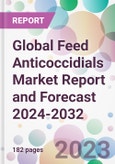According to the report, the global feed anticoccidials market is projected to grow at a CAGR of 4.2% between 2024 and 2032 reaching a value of around USD 476.77 million by 2032. Aided by the increasing global demand for meat products and the imperative need for maintaining livestock health, the market is expected to grow significantly by 2032.
Feed anticoccidials are specialised drugs or compounds added to livestock feed to prevent and treat coccidiosis, a parasitic disease affecting the intestinal tracts of animals, particularly poultry. Caused by the protozoan parasites of the genus Eimeria, coccidiosis can lead to reduced feed conversion, weight gain, and, in severe cases, death. Thus, the efficient management and control of this disease are vital for the overall productivity and profitability of the livestock industry.
The escalating global consumption of meat, especially poultry, acts as a primary driver of the feed anticoccidials market growth. As the world's population grows and the dietary preferences shift towards protein-rich diets, the pressure on the livestock industry intensifies, emphasising the importance of livestock health and disease prevention. The efficient control of coccidiosis directly translates to enhanced meat production, making anticoccidials an indispensable component of livestock feed.
Additionally, the burgeoning research in the field of veterinary medicine and animal feed formulation is paving the way for innovative and effective anticoccidial solutions. The modern anticoccidials not only offer disease prevention but also ensure minimal residues in the meat, aligning with the global trend of clean-label meat products.
The pharmaceutical industry's role is a crucial sector generating the feed anticoccidials market demand significantly. Leading pharmaceutical companies are investing in research and development activities to produce novel anticoccidial drugs that can effectively combat drug-resistant strains of the parasite. Simultaneously, there's an ongoing shift towards natural and organic anticoccidials, reflecting the global move towards sustainable and organic farming practices.
On a regional analysis, North America, with its advanced livestock rearing practices and stringent animal health regulations, occupies a significant portion of the feed anticoccidials market share. Europe follows suit, driven by its emphasis on sustainable farming and high meat consumption rates. However, the Asia-Pacific region, with its rapidly growing livestock industry and escalating meat consumption, especially in countries like China and India, is projected to emerge as the most lucrative market in the coming years.
Feed anticoccidials are specialised drugs or compounds added to livestock feed to prevent and treat coccidiosis, a parasitic disease affecting the intestinal tracts of animals, particularly poultry. Caused by the protozoan parasites of the genus Eimeria, coccidiosis can lead to reduced feed conversion, weight gain, and, in severe cases, death. Thus, the efficient management and control of this disease are vital for the overall productivity and profitability of the livestock industry.
The escalating global consumption of meat, especially poultry, acts as a primary driver of the feed anticoccidials market growth. As the world's population grows and the dietary preferences shift towards protein-rich diets, the pressure on the livestock industry intensifies, emphasising the importance of livestock health and disease prevention. The efficient control of coccidiosis directly translates to enhanced meat production, making anticoccidials an indispensable component of livestock feed.
Additionally, the burgeoning research in the field of veterinary medicine and animal feed formulation is paving the way for innovative and effective anticoccidial solutions. The modern anticoccidials not only offer disease prevention but also ensure minimal residues in the meat, aligning with the global trend of clean-label meat products.
The pharmaceutical industry's role is a crucial sector generating the feed anticoccidials market demand significantly. Leading pharmaceutical companies are investing in research and development activities to produce novel anticoccidial drugs that can effectively combat drug-resistant strains of the parasite. Simultaneously, there's an ongoing shift towards natural and organic anticoccidials, reflecting the global move towards sustainable and organic farming practices.
On a regional analysis, North America, with its advanced livestock rearing practices and stringent animal health regulations, occupies a significant portion of the feed anticoccidials market share. Europe follows suit, driven by its emphasis on sustainable farming and high meat consumption rates. However, the Asia-Pacific region, with its rapidly growing livestock industry and escalating meat consumption, especially in countries like China and India, is projected to emerge as the most lucrative market in the coming years.
Market Segmentation
The market can be divided based on type, livestock, form, source, mode of consumption, and region.Market Breakup by Type
- Monensin
- Lasalocid
- Salinomycin
- Nicarbazin
- Diclazuril
- Narasin
- DOT (Dinitro-O-Toluamide)
- Others
Market Breakup by Livestock
- Poultry
- Swine
- Ruminants
- Others
Market Breakup by Form
- Dry
- Liquid
Market Breakup by Source
- Chemical
- Natural
Market Breakup by Mode of Consumption
- Oral
- Injection
Market Breakup by Region
- North America
- Europe
- Asia Pacific
- Latin America
- Middle East and Africa
Competitive Landscape
The report looks into the market shares, plant turnarounds, capacities, investments, and mergers and acquisitions, among other major developments, of the leading companies operating in the global feed anticoccidials market. Some of the major players explored in the report are as follows:- Elanco Animal Health Incorporated
- Huvepharma EOOD
- Phibro Animal Health Corporation
- Zoetis Services LLC
- Kemin Industries, Inc.
- Qilu Animal Health Products Co., Ltd.
- Virbac S.A.
- Others
Table of Contents
1 Preface2 Report Coverage - Key Segmentation and Scope4 Key Assumptions7 Opportunities and Challenges in the Market16 Key Trends and Developments in the Market
3 Report Description
5 Executive Summary
6 Market Snapshot
8 Global Feed Anticoccidials Market Analysis
9 North America Feed Anticoccidials Market Analysis
10 Europe Feed Anticoccidials Market Analysis
11 Asia Pacific Feed Anticoccidials Market Analysis
12 Latin America Feed Anticoccidials Market Analysis
13 Middle East and Africa Feed Anticoccidials Market Analysis
14 Market Dynamics
15 Competitive Landscape
List of Key Figures and Tables
Companies Mentioned
- Elanco
- Huvepharma
- Phibro Animal Health (NASDAQ: PAHC)
- Zoetis (NYSE: ZTS)
- Kemin Industries
- Merck Animal Health
- Virbac S.A (EPA: VIRP)
Methodology

LOADING...








